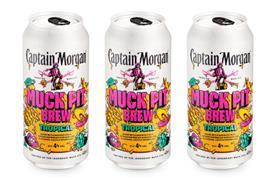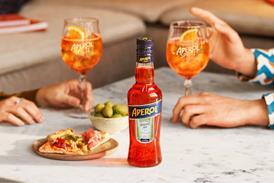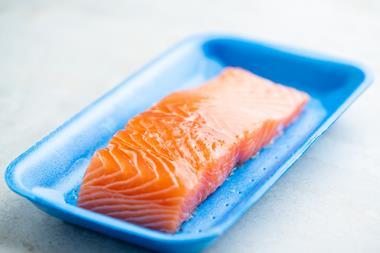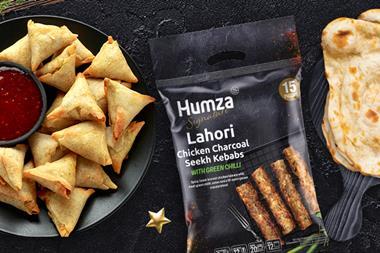The truth of the matter is that the fresh/chilled market is thriving, at least in part, and for two reasons: other sources of supply, such as the Indian Ocean and the Pacific, are replacing North Atlantic stocks, which are in trouble. And farmed fish tonnages from many sources are rising.
Seafood consumption in the UK lies just under the EU average, at 20kg per capita. According to TNS figures for the Seafish Industry Authority, cod continues to top the popularity table, although retail sales have gone down 23% over the past five years. Haddock sales have declined by 14% in the same period, while salmon, prawns and shellfish and pelagic fish have risen.
The authority recorded some positive changes in consumer attitudes and purchasing, with a general rise in consumption across all age groups, but most notably among younger people.
Tony Mogan, its head of marketing, says: "Our most recent research showed that 30-year-olds are buying more fresh and chilled seafood today than they did 10 years ago. Ninety per cent of 27 to 34-year-olds are buying frozen seafood, which is an increase compared with 10 years ago, with healthy and premium ranges driving sales."
Seafish organised the first National Seafood Week in October 2001, which was embraced by retailers and brought an increase in fish sales during the promotion. A second week will take place from October 4-11 this year and retailers are encouraged to contact Seafish to get involved. "This year offers tremendous scope for retailers," says Mogan.
Iain McSween, of the Seafish Board, says quality has become a driving issue in today's seafood market because of the highly competitive supply situation. "Supermarkets, by virtue of their buying power, have been able to enforce quality disciplines on the fishing and processing industries that were absent. Their justification for these often costly measures is that, as a retailer, they are answerable to their customers who want produce that meets the highest standards." Sainsbury tops the supermarkets in terms of fresh fish and seafood sales, but Tesco has increased its share over the year to challenge this position. If frozen and canned fish are included, Tesco leads the overall market with a 19.8% share, followed by Sainsbury with 16.6%, Asda at 10.6% and Marks & Spencer at 8.3%.
Iain Mahood, of M&S, says prepacked fish sales grew around 20% in 2001, following a pattern set over the past three years. "We have seen increased demand in general as a result of many factors, not least of which is the improved awareness of fish as a healthy part of a balanced diet," he says. In developing this trend further, M&S believes that absolute freshness and quality, excellent butchery and presentation, and skinless and boneless portions will be just an entry qualification. "There is an increasing groundswell of opinion towards a more responsible approach to food production and we are responding to that," he adds.
Sainsbury's fish buyer, Craig Leach, says its customers are increasingly keen to try new and exotic species. "We introduced Mahi Mahi fillets at the beginning of the year and will launch Red Emperor fillets in March and Wahoo fillets in May. These come from sustainable fisheries in the Seychelles and demonstrate our commitment to the future of the oceans," he says.
Marr Foods, the UK's largest independent processor of fresh, chilled, frozen, smoked, poached fish and seafood products to the major multiples, has completed a £2m upgrade of its facilities. The installation of new customised processing and packing lines has enabled the company to produce innovative packaging that enhances the appearance of products. Its cod and coley portions were relaunched in new packaging at the end of 2001, while its seafood sticks were repackaged in flow wrap film, which extends the shelf-life. Trade marketing manager Kelly Colrein says considerable effort goes into R&D.
Marr Foods was awarded an on-product logo licensing agreement for wild Alaskan Salmon with the Marine Stewardship Council in 2001 and further work has begun to develop more MSC-labelled value-added products.
Young's Seafood has also turned to the MSC for environmental validation, and its CEO Mike Parker is a trustee of the organisation. Young's introduced a Fish for Life' range in the autumn which carries the strapline Good for me and Good for the sea'.
MSC chief executive Brendan May is delighted that UK processors are making environmental issues a priority and actively seeking to use products from MSC eco-labelled fisheries. "It is through the commitment of responsible companies that consumers will increasingly be able to choose labelled products, in the confidence that they do not contribute to the global problem of overfishing," he says.
Young's growth strategy for fish has been to bring it up to date and make it accessible to the consumer. The company's approach aims to push convenience and creativity into the fish category, as has been done with poultry with such stunning success.
Young's brand was relaunched a year ago with a raft of new products, packaging and consumer advertising, that was the first major specialist investment in the seafood category for nearly 20 years. In the 12 months to December 2001, Young's achieved growth of nearly 20% and passed the £100m mark for the first time in its history. The strategy for 2002 is to build on the momentum.
{{FOCUS SPECIALS }}
Close menu
- Home
- Retail & Wholesale
-
Products & Suppliers
- Back to parent navigation item
- Products & Suppliers
-
Product Categories:
- Back to parent navigation item
- Product Categories:
- Alcoholic drinks
- Bakery
- Cereals & breakfast
- Cheese
- Chicken & poultry
- Chocolate
- Confectionery
- Crisps, nuts & snacks
- Dairy
- Fish
- Fresh produce
- Frozen
- Household
- Meat
- Own Label
- Sauces & condiments
- Seasonal
- Soft drinks
- Vaping
- Vegan & plant-based
- World foods
- Suppliers
- People
- Reports & Data
-
Topics A-Z
- Back to parent navigation item
- Topics A-Z
-
Popular topics:
- Back to parent navigation item
- Popular topics:
- Cost of living crisis
- Crime
- Deposit Return Schemes
- Finance
- Government & Regulation
- Health
- Inflation
- Loyalty
- Marketing
- Mergers & Acquisitions
- New Product Development
- Sourcing
- Supply chain
- Sustainability & environment
- Technology
- Ultra Processed Foods
- Vaping
- A-Z all topics
- Content by type:
- Events
- Subscribe now
Sign in to comment on this article
Not logged in before? Register for FREE guest access today.
You will be able to:
- Read more stories
- Receive daily newsletters
- Comment on stories
Advert

















No comments yet